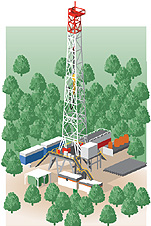

Constructing
Wellbore Junctions
Drilling several drainholes from a primary borehole is more common
than ever before. Multiple well branches, or laterals, increase
productivity by contacting more reservoir than single-bore wells.
These completions have several advantages over conventional vertical
and horizontal wells, including improved reserve recovery.
Multilateral completions involve additional equipment, but potentially reduce overall capital expenditures, development costs and operational expenses by decreasing the total number of wells. Fewer wellbores to surface reduce exposure to shallow drilling risks.
Multilateral wells require fewer wellheads, platform risers and subsea completions, and optimize slot utilization on offshore platforms or seafloor templates. Onshore, multilateral wells minimize surface location size and environmental impact.
Advanced completions use mechanical assemblies to provide a strong connection, pressure integrity and selective lateral access at junctions between liners and the main wellbore casing.
In new or existing wells, RapidConnect and RapidExclude multilateral completion systems create a stable connection between liners and primary casing. These junctions also facilitate selective reentry access.
For reliable lateral junctions in new dual-lateral wells, the RapidSeal
multilateral completion system provides pressure integrity and selective
reentry access.
Multilateral wells vary in configuration and classification , depending
on specific reservoir application.
[note1]
In addition to reentry of existing wells, more than 10% of the 70,000 new wells drilled each year are viable candidates for future multilateral completions.
Continue to Junction Stability and Sand Exclusion
|
|



